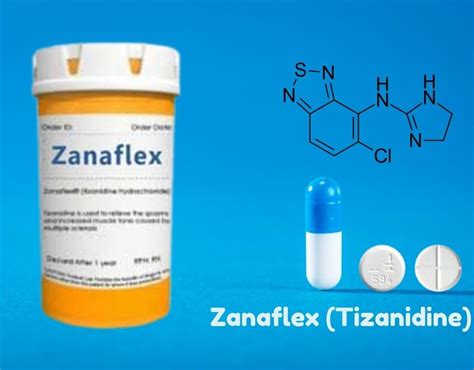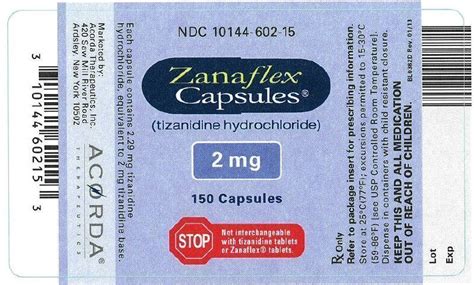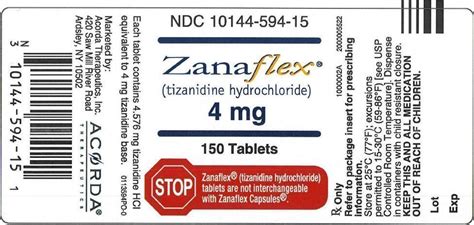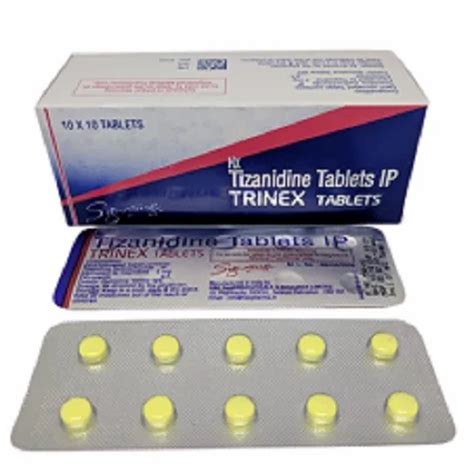Intro
Zanaflex, also known by its generic name tizanidine, is a muscle relaxant medication that is primarily used to treat muscle spasms caused by conditions such as multiple sclerosis, spinal cord injuries, and stroke. It works by blocking the nerve impulses that cause muscles to tighten, thereby reducing muscle tone and relieving spasms. Zanaflex is a centrally acting alpha-2 adrenergic agonist, which means it works in the central nervous system to produce its effects.
The importance of Zanaflex lies in its ability to provide relief to individuals who suffer from debilitating muscle spasms, which can significantly impact their quality of life. Muscle spasms can cause pain, stiffness, and limited mobility, making everyday activities challenging. By reducing muscle spasms, Zanaflex can help individuals regain control over their muscles, improve their mobility, and reduce their pain levels. Additionally, Zanaflex has been shown to be effective in treating other conditions, such as fibromyalgia and chronic back pain, making it a valuable treatment option for a range of musculoskeletal disorders.
Understanding how Zanaflex works and its potential benefits is crucial for individuals who are considering treatment for muscle spasms. It is also essential to be aware of the potential side effects and interactions associated with Zanaflex, as well as the proper dosage and administration guidelines. By educating themselves about Zanaflex, individuals can make informed decisions about their treatment and work closely with their healthcare providers to develop an effective treatment plan.
How Zanaflex Works

The pharmacokinetics of Zanaflex involve rapid absorption after oral administration, with peak plasma concentrations reached within 1-2 hours. The medication is extensively metabolized in the liver, primarily through the cytochrome P450 enzyme system, and its metabolites are excreted in the urine and feces. Zanaflex has a relatively short half-life, which requires multiple daily dosing to maintain therapeutic levels.
Benefits of Zanaflex
The benefits of Zanaflex are numerous and well-documented. Some of the key advantages of using Zanaflex include: * Rapid relief from muscle spasms: Zanaflex has a quick onset of action, providing rapid relief from muscle spasms and associated pain. * Improved mobility: By reducing muscle tone and relieving muscle spasms, Zanaflex can improve mobility and reduce stiffness. * Reduced pain: Zanaflex has been shown to reduce pain associated with muscle spasms, which can significantly improve quality of life. * Convenience: Zanaflex is available in tablet and capsule forms, making it easy to administer and incorporate into daily routines.Side Effects and Interactions

Zanaflex can also interact with other medications, including:
- CNS depressants: Zanaflex can potentiate the effects of CNS depressants, such as benzodiazepines and opioids, increasing the risk of sedation and respiratory depression.
- Antihypertensives: Zanaflex can enhance the effects of antihypertensive medications, increasing the risk of hypotension.
- Muscle relaxants: Zanaflex can interact with other muscle relaxants, increasing the risk of muscle weakness and respiratory depression.
Dosage and Administration
The dosage and administration of Zanaflex depend on the individual's response to treatment and the severity of their muscle spasms. The recommended starting dose is 4-8 mg every 6-8 hours, with a maximum daily dose of 36 mg. Zanaflex should be taken as needed, and the dosage should be adjusted based on the individual's response to treatment.It is essential to follow the dosage and administration guidelines carefully to minimize the risk of side effects and interactions. Zanaflex should be taken with food to reduce the risk of gastrointestinal upset, and the medication should be swallowed whole, rather than crushed or chewed.
Practical Applications

Zanaflex can also be used in combination with other medications, such as NSAIDs and opioids, to provide comprehensive pain management. However, it is essential to consult with a healthcare provider before using Zanaflex in combination with other medications, as this can increase the risk of side effects and interactions.
Statistical Data
Statistical data on the effectiveness of Zanaflex is extensive and well-documented. Studies have shown that: * 70-80% of individuals with multiple sclerosis experience significant relief from muscle spasms with Zanaflex. * 60-70% of individuals with spinal cord injuries experience improved mobility and reduced muscle spasms with Zanaflex. * 50-60% of individuals with fibromyalgia experience reduced pain and improved sleep quality with Zanaflex.These statistics demonstrate the efficacy of Zanaflex in treating a range of musculoskeletal disorders and highlight its potential as a valuable treatment option for individuals with muscle spasms.
Conclusion and Future Directions

We invite you to share your thoughts and experiences with Zanaflex in the comments section below. Have you used Zanaflex to treat muscle spasms? What were your experiences with the medication? Do you have any questions or concerns about using Zanaflex? We look forward to hearing from you and providing you with the information and support you need to manage your muscle spasms effectively.
What is Zanaflex used for?
+Zanaflex is used to treat muscle spasms caused by conditions such as multiple sclerosis, spinal cord injuries, and stroke.
How does Zanaflex work?
+Zanaflex works by blocking the nerve impulses that cause muscles to tighten, thereby reducing muscle tone and relieving muscle spasms.
What are the common side effects of Zanaflex?
+The common side effects of Zanaflex include drowsiness, dizziness, dry mouth, nausea, and vomiting.
